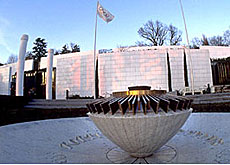
Olympic dream lives on

The Olympic Museum in Lausanne is celebrating its tenth anniversary with a series of special events, highlighting the achievements of the Olympic Movement.
The classical modernist-style museum, which cost more than SFr118 million ($89 million), commands a stunning position overlooking Lake Geneva.
It presides over well-tended gardens filled with fountains and sculptures of athletes with rippling muscles.
But it is the artefacts on display that fire the imagination, and remind one of the spirit of human endeavour that is at the heart of the movement.
Near the entrance is a simple construction – a bar balancing on top of two poles.
This is the high-jump set to the very level – 2.45 metres – that Javier Sotomayor of Cuba cleared to win the gold medal in the 1992 Barcelona Olympics.
Most people would find it impossible to even touch the bar with their hand, let alone jump over it. It is a most extraordinary record of achievement.
Inside the building are more testimonies to the dedication and determination of international athletes. Not all of them were record breakers – the Olympic ideal is the taking part, not the victory.
Memorabilia
The founding father of the modern Olympic Games, Pierre Coubertin, brought with him a large collection of artefacts when he moved the International Olympic Committee (IOC) from Paris to Lausanne in 1922.
Juan Antonio Samaranch made it a priority to complete the Coubertin collection when he became IOC president in 1980.
Museum buyers went on shopping sprees, trawling auctions, and soliciting the world’s sporting nations for mementoes to supplement the existing store of exhibits.
The buyers also attended the Games, to persuade winners to donate their prizes. This is how most of the artefacts ended up in the museum.
The first floor is dedicated to memorabilia of medal winners from the earliest Games through to the present, from the shoes that carried Jessie Owens to four gold medals in the 1936 Olympics, to the revolutionary bike used by Chris Boardman at the 1992 Barcelona Games.
The evolution of many events is clearly charted. We see the first crude bamboo vaulting poles, juxtaposed with today’s sophisticated fibreglass poles, which lifted 1988 Olympic champion Sergei Bubka to a height of over six metres.
Lighting the way
The museum is the final resting place of the Olympic torches from both the Summer and Winter Games, starting with the first from the 1936 Berlin Olympics.
The coveted gold, silver and bronze medals that most of the world’s athletes can only dream of winning glint from glass display cabinets.
Video screens throughout the exhibitions recall the special moments of the Games that have given the world so much pleasure over the years.
Scandals
Scandals have sometimes dogged the Games, among them the problem of doping. There is a section on the first floor dedicated to the subject.
But there is no mention among the Salt Lake City artifacts of the corruption case that marred the 1992 Games. When it emerged that Salt Lake City had won its bid for the Games by wooing IOC members with gifts, ten members were expelled or forced to resign.
The museum’s special events organiser, Stephane Meylan, maintains that the media was much more interested in the bribery story than the public ever was.
“When people think back to the Salt Lake City Games, I believe they will remember the moment when the US flag entered the stadium. It was just a few months after September 11. ”
It was the very same flag that had flown at New York’s World Trade Center during the terrorist attack. Its arrival in the arena brought tears to the eyes of viewers around the world.
This Olympic Games became a focus for national pride, a symbol of human achievement after the most devastating manifestation of man’s inhumanity to man.
This is Pierre Courbertin’s legacy. He created an event that continues to bring people of all races and creeds together in the pursuit of sporting excellence.
swissinfo, Julie Hunt
4 – 21 June: “History of the Olympic Museum” exhibition at the Town Hall Forum. Olympic trail in the city, and competition.
22 June: Open Door Day to the Museum and its exhibitions. Activities and competitions.
23 June: Museum birthday surprise for young people.
12 – 16 October: Ten-year anniversary edition of Olympic Week.
1894 – Pierre de Coubertin founded the International Olympic Committee in Paris
1896 – the first Olympic Games of the modern era were held in Athens.
1st World War – Coubertin requested relocation of IOC HQ to neutral Switzerland
1922 – IOC headquarters and the Museum collections move to Lausanne
1993 – New museum with an expanded collection of artefacts opens in Lausanne

In compliance with the JTI standards
More: SWI swissinfo.ch certified by the Journalism Trust Initiative


























You can find an overview of ongoing debates with our journalists here . Please join us!
If you want to start a conversation about a topic raised in this article or want to report factual errors, email us at english@swissinfo.ch.